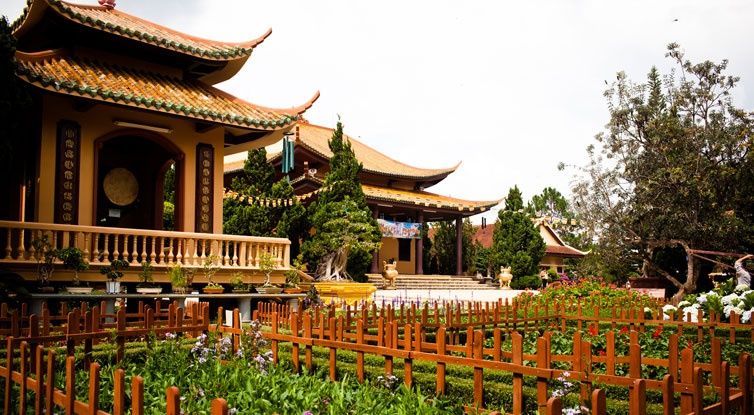Truc Lam Monastery: A Haven of Beauty and Peace

Truc Lam Monastery is located at Phuong Hoang (Phoenix) Hill near Da Lat City in the Central Highlands. Opened in 1994, it has since attracted visitors from all over the world because of its inherent tranquility and beauty which resonated with anyone who went inside the monastery.
Chan Buddhist Monastery is located 5 kilometers from Da Lat City. Occupying an area of 1,600 meters, it is the biggest monastery in the city and one of three specializing in the Truc Lam Yen Tu sect, a one-of-a-kind Vietnamese form of Chan established during the Tran dynasty in 1225-1400 (the other two are Truc Lam Yen Tu monastery in Quang Ninh Province and Truc Lam Tay Thien in Tim Dao, Vinh Phuc Province). It was founded by Buddhist monk Thich Thanh Tu with the purpose of bringing “new life” to the Truc Lam Yen Tu sect or recreating the spirit of Chan Buddhism during the Tran dynasty.
Chan monastery was designed specifically by architects Vu Xuan Hung and Tran Duc Loc, but with a little help from Ngo Viet Thu, designer of the Re-unification Palace in Ho Chi Minh City. In the monastery, monks meditate three times a day starting at 3am and each session lasting up to two hours. It was Emperor Tran Nhan Tong who introduced Chan tradition to Vietnam. After defeating the Mongol-Yuan troops of China, he gave up his throne, passed it to his son and became a Buddhist monk. He stayed at the mountain of Yen Tu to practice his newfound religious life and later travelled around the country to spread the philosophy he formulated. To create a Vietnamese version of Chan, Emperor Tong fused the the three sects of the tradition which originally came from China into a new Vietnamese tradition known as Truc Lam.
The original Chan tradition in China was said to be founded by Indian Buddhist monk Bodhidharma. His objective was to help people “live in full awareness while putting their minds into a peaceful state.” The tradition focuses on “interior concentration,” producing “personal purification and helps one's good nature to surface.”
Truc Lam monastery can be reached in three ways. One is directly through the entrance with 61 steps to take from the road next to the hill. The second is through the Tuyen Lam Lake with 200 stone steps and three-gated entrance to go through before reaching the place. Another way, and probably the easiest and even enjoyable, is a 2.3 kilometer cable ride from Robin Hill. For VND50,000 (US$2.50) return trip fare, the ride gives you a beautiful view of Da Lat.
Trc Lam monastery sits on a 24-hectare land, the biggest monasctic grounds in Vietnam. Two hectares of the whole place has been set up with buildings divided between domestic and public, the former being for monks and nuns and off-limits to the public. There are about 50 monks and 50 nuns in the monastery. The public area is composed of a ceremonial hall, guest facilities, and another hall which is used only every 14th and 29th day of the lunar month, or the eve of the full moon and the new moon. During this time, the abbotts gather and talk to students about meditation.
A two-meter high statue of Gautama Buddha is one of the most fascinating sights in the monastery. Seated on a lotus and holding another one in his right hand, the rock image symbolizes the philosophy of “existence in nihilism.” A flower garden in the holy place gives its visitors a beautiful and peaceful feeling, the overall feeling one feels when staying inside Truc Lam monastery.









